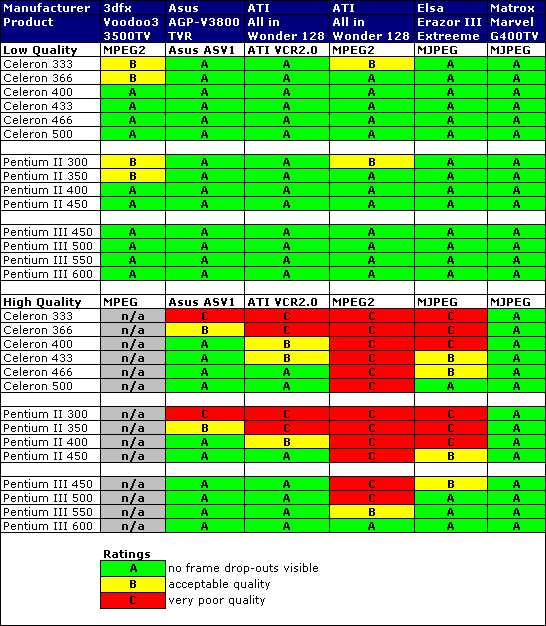Multitalented: All-in-One Graphic Boards
Benchmarks - Requirements For Jitter-free Pictures
Some chips show their strengths when recording, others during video playback. The following table shows the relationship between these two aspects. Taking the CPU into consideration, we recorded a video and then played it back. We then evaluated the subjective impression of the video quality. We always used the standard format of the board. This means that formats were excluded that would have been generated after post-conversion. For example, the LSX Transcoder is included with the Matrox product and is used to convert the proprietary MJPEG standard into the MPEG 2 format. During this test we placed the emphasis on the investigation of the hardware and drivers.
The 3dfx product is not included in the high resolutions, as it does not support these. The Matrox board handled the tasks at hand with virtually no problems. The MJPEG videos are virtually jitter-free on all three CPUs. Unfortunately, this positive result is achieved at the price of disk space. MJPEG videos are sometimes up to five times larger than MPEG 2 videos.
This table shows the limitations of ATI's All in Wonder 128: although the Rage 128 is an expert when it comes to MPEG 2 video playback, the recording process is not supported in hardware; instead a software codec has to hold the fort. Summarizing, the All in Wonder 128 can deal with a slow CPU if you are only playing back MPEG 2/DVD videos. For recording (at least for qualitatively high resolutions - full TV resolution), you'll need a powerful CPU such as a Pentium III 550/ Athlon 500 or more. At least the ATI codec is more effective than that of the Voodoo3 3500TV.

Stay On the Cutting Edge: Get the Tom's Hardware Newsletter
Get Tom's Hardware's best news and in-depth reviews, straight to your inbox.
Current page: Benchmarks - Requirements For Jitter-free Pictures
Prev Page Benchmarks - CPU Workload During Playback Next Page Copy ProtectionMost Popular

